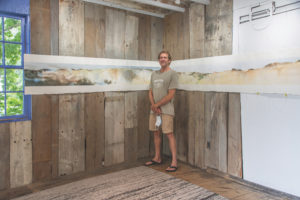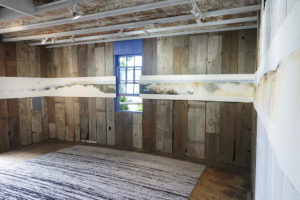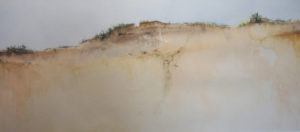
Over the last seven weeks, while painting Edge of the Continent/Center of the World, a 64-foot-long watercolor of the Outer Cape dunes, Mark Brennan has been listening to Beethoven.
“I usually don’t listen to music when I’m working, because I really have to concentrate, but this project has involved a lot of soaking, cutting, taping, measuring, stapling — those sorts of chores that are part of painting,” Brennan says. “I went through my drawers and found an old box set of the complete Beethoven symphonies. I’ve listened to them, basically on a loop, all through the month of July.”
The spirit of Beethoven has clearly infiltrated the painting. Now completed, it has been installed at the Off Main Gallery in Wellfleet, snaking around the wooden walls, folding around door frames, occasionally interrupted by windows. It opened on Saturday and is on view through Sept. 11. Viewers are encouraged to wander around the gallery in a similarly circuitous route.
“Unlike normal art-looking,” Brennan says, “it is more like listening to music, because you observe it in a sequence, and it unfolds over time.”

The Outer Cape’s dunes have always figured large in Brennan’s mind. “Growing up, our family had a house right on top of the dunes, a little bit past Newcomb Hollow. June to September, this was the ’60s and ’70s, that’s where I played. Every day, I would go up and down the dunes. It really wasn’t forbidden in those days. Then, when I got to be 20-ish and more serious about art, I would go there to draw.” Brennan, now an artist and teacher, splits his time between Brooklyn and Wellfleet.
He had toyed with the idea of doing a panoramic painting for years, but it was the pandemic that provided the ideal opportunity. He persuaded Robert Shreefter to open up the Off Main Gallery, which had gone completely virtual. He chose to work in watercolor so it could be executed quickly, but the medium was appropriate for many reasons.
“Something about the fluidity and transparency of watercolor lends itself to the dunes,” Brennan says. Just as the dunes are both timeless and ever-changing, watercolor is easily manipulated yet unerasable.
Brennan started with photographs but soon turned to his imagination. The contours of the dunes are so clear in his mind that a reference point was unnecessary. He painted dune grasses using a technique called “scumbling,” dragging a dry brush against the tooth of the paper.
“Because you have these broad washes, your eye searches for an edge,” he says. “And that is what the dunes are all about. They are these vast areas of sand and sky, but the eye always tries to find the edge, that little tree, that little spot of beach grass, even if it is a tiny speck against that huge space.”
Brennan says his work draws inspiration from traditional Chinese handscrolls. “They would be rolled up, and you would sit at a table and unfurl them as you go,” he says. “The experience simulated walking through the woods and seeing the streams and mountains and fishing boats.” These handscrolls also evoke the insignificance of man in relation to the vastness of nature. The medium is similar to watercolor, though monochrome: just water and ink.

Viewing Brennan’s installation is similar to unfurling a scroll — or traversing the dunes — and the musical metaphor soon becomes apparent. The painting starts off gradually, with small splotches of paint, like the opening motif of a symphony. The amorphous, watery forms begin to resemble dunes. In the first room, they are more realistic, almost photographic.
As the painting meanders into the back room, however, it becomes more abstract. Brennan uses opposing colors — oranges and blues, greens and reds. Eventually, there is no longer a delineation between land and sky. The imagery suggests a sandstorm.
As the painting progresses, the dunes become cloaked in shadow, as if in winter. Suddenly, the piece has adopted a minor key. In the painting’s culmination, the dunes are engulfed by rays of light, purples and yellows. “It is like the ‘Ode to Joy,’ ” Brennan says, referring to the final movement of Beethoven’s Ninth, his last symphony.
While this is a perfect “ending” to the watercolor, one advantage that it has over a Beethoven symphony is that it can be experienced in any order or direction. “You can go forwards, backwards, or start in the middle and go both ways. It is really up to you,” Brennan says. And it only gets better with repeated viewing.
Sands of Time
The event: The installation of Edge of the Continent/Center of the World, a 64-foot watercolor on paper by Mark Brennan
The time: On view through Sept. 11: Wednesday and Thursday, noon to 6 p.m.; Friday and Saturday, 2 to 8 p.m.; and by appointment (508-514-1326)
The place: Off Main Gallery, 326 Main St. Rear, Wellfleet
The cost: Free; Brennan is selling the watercolor in segments, $200 per foot



